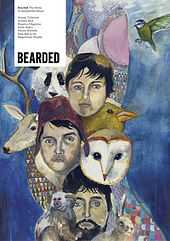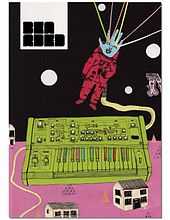Bearded (magazine)
 | |
| Editor | Suzi Ireland |
|---|---|
| Categories | Music magazine |
| Frequency | Bi-Monthly |
| Publisher | Fleeing from Pigeons |
| First issue | 14 August 2007 |
| Country |
|
| Language | English |
| Website | beardedmagazine.com |
Bearded is a British bi-monthly music magazine that distributes nationwide through WHSmith, Borders, independent record shops and newsagent's shops. The magazine covers the independent music industry and only reviews artists who are either unsigned or signed to independent record labels.
Bearded is known[citation needed] for its high quality print[citation needed] which uses 100% recycled paper stock and its very high standard of art direction[citation needed] - commissioning illustrations from artists such as David Shrigley and Paul Davis.
Mission statement

Starting from issue FFP. E in January 2009, Bearded have published a mission statement to reassert the reasons for the magazine's existence. This statement also appears on the magazine's website under the 'About Us' heading.
The statement, in full, is:
Bearded exists to generate coverage for independent labels and artists regardless of genre, background or how fashionable they are.
Bearded aims to do this in a publication that has top quality art direction and design at its heart, with writing that allows the reader to form their own opinions rather than being told what to think and what to like.
Bearded’s editorial direction is not dictated by advertisers, distributors or anybody else that might generate monetary support. It is put together exclusively by music lovers for music lovers – like a conversation in a pub, but with much nicer paper.
Bearded tries to make its money simply through magazine sales and Beardaid support. Help us carry on making beautiful, refreshing and unwavering publications at: www.beardaid.co.uk.
History

The first issue of Bearded was released on 14 August 2007 with an illustration of actor and musician Matt Berry on the cover. The design of the cover was minimal, with the original, barely readable Bearded logo being the only branding with no contents or other information on the front. This design continued through the first 18 months of the magazine, until Bearded relaunched into WHSmith and other major retail stores on 29 January 2009 where the logo changed and a few contents were subtly inserted into the cover. It did though retain the minimal aesthetic.
Bearded is printed on high quality, 100% recycled heavyweight paper stock that is uncommon[citation needed] in the music magazine marketplace (which tends to have an emphasis on basic stock[citation needed]). Its art design is minimal throughout, with a heavy emphasis on white space and readability as opposed to cluttering the pages with text and information. Full page illustrations from unknown and famous artists are common[citation needed], and the writers are generally unknown in music journalism. The magazine has become known[citation needed] as a useful stepping stone for young writers, with many now working at major publishing houses.
Beardaid
On 14 July 2008, Bearded announced the launch of Beardaid, a charitable side to the magazine that aimed to further help people working in the independent music industry by offering exclusive records, magazines, gigs and merchandise to supporters who donated £2 a month to the scheme. Beardaid would then offer independent labels subsidised advertisements in Bearded to help them reach a wider audience previously unreachable due to cost.[2]
Gareth Main stated at the launch: "Bearded launched... with the express aim of generating national coverage for the independent music sector. Since then, over 100,000 people have picked up a copy or been through our website and we want to utilise that popularity in a way that will not only help Bearded survive into the future, but also help independent labels get more coverage than they could have dreamt imaginable."
Notable artists featured

Amongst others, Bearded has featured Matt Berry, Animal Collective, Polyphonic Spree, Fiery Furnaces, Future of the Left, Misty's Big Adventure, Robert Wyatt, Stanley Brinks, David Shrigley, British Sea Power, Jeffrey Lewis and Adele.
Bearded has also run features on a number of record labels, including Trunk Records and Stiff Records.
Critical reaction
After the magazine's launch, it gained a positive response from the online community. Online Journalism blogger Paul Bradshaw heralded the magazine's "web-savvy business model"[3] whilst Created in Birmingham's Pete Ashton commented on Bearded's "very impressive start." [4]
Cover star and star of Channel 4's The IT Crowd Matt Berry said of the lead feature on him, "I love it, love the article and love you."[5]
Content
The flow of Bearded is follows a chronological timeline. The magazine starts with reviews of live events (the past), continues with news and features (the present) and ends with listings and reviews of future releases (the future). The break to this line comes in the feature From the Euphotic Depths on the second to last page where one of the contributors talks about their love for a band long forgotten.
Another regular feature is the Bearded Sluice Box, where a handful of emerging artists are highlighted for readers to investigate further.
References
- ↑ MediaCourses.com: The Department of Media and Communication, Birmingham City University | Degrees in Media, Web Design, Photography, PR, Music Industries, Radio, TV & Journalism; MAs in Broadcast Journalism, Television and Interactive Content, Event & Exhibition Management, Creative Enterprise; research degrees in media
- ↑ » Beardaid launches Bearded Magazine: The home of independent music
- ↑ Independent music magazine shows a web-savvy business model « Online Journalism Blog
- ↑ Created in Birmingham » Bearded Launched
- ↑ Bearded Magazine :: When the country is in the brown, independent music gets BEARDED
External links
- Bearded website – includes forum, exclusive downloads from featured artists and a platform for viewing the latest issue